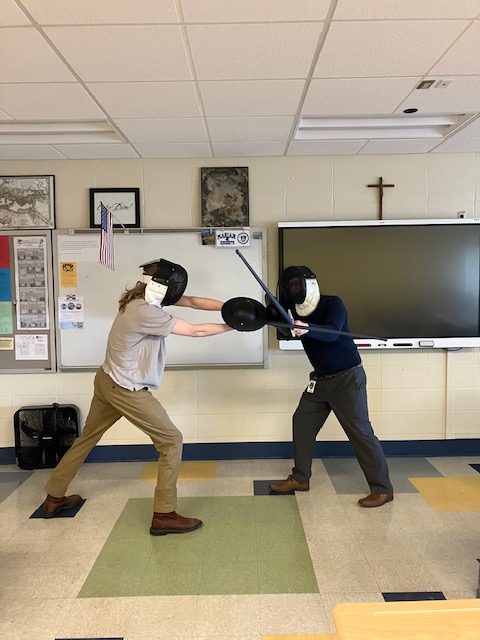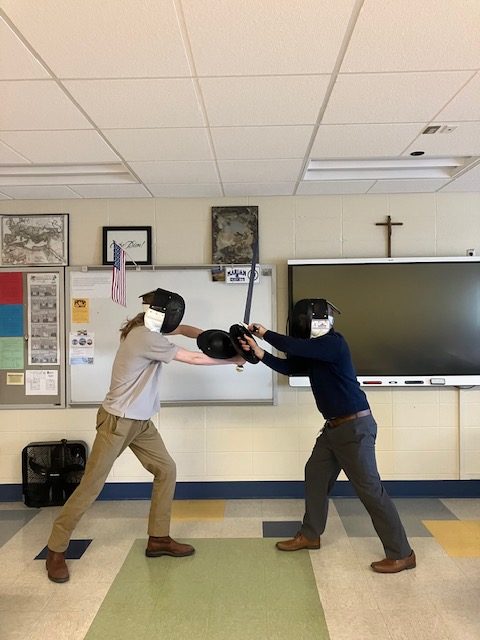March 8, 2024 // Diocese
Marian Teacher Receives Grant to Study Fencing Overseas

Provided by Marian High School
Thomas duToit, a Latin and Greek teacher at Marian High School, received a grant from the Lilly Endowment to study medieval fencing in Germany.
Thomas duToit first heard about medieval fencing from YouTube. Now, thanks to a Lilly Endowment grant, the teacher at Marian High School in Mishawaka will be traveling to Germany to take private lessons in medieval fencing and participate in an international tournament.
The Lilly Endowment’s Teacher Creativity Fellowship Program awards grants every year that allow Indiana teachers to pursue their interests. DuToit, a Latin, Greek, and philosophy teacher at Marian, was one of nearly 100 teachers to receive a grant this year. A former Marian teacher received a Lilly grant several years ago, and duToit said that put his “radar up.”
DuToit said his first exposure to fencing was through his dad, who did Olympic-style fencing for fun. (Olympic-style fencing is the type that is perhaps more widely recognizable – white uniforms, wire mesh masks.) While his father had stopped fencing by the time duToit, the seventh child, came along, duToit remembers seeing some of the equipment and books on fencing around the house. “I think that’s what turned me on initially,” duToit told Today’s Catholic.
When duToit moved to the South Bend area in his 30s,
he heard about the Indiana Fencing Academy in Mishawaka. “So I called them up and asked, ‘Do you give lessons to old guys?’” duToit remembered. For a while, he took lessons during the summers when he wasn’t teaching. “I really dug it,” duToit said.
“I’ve never competed in Olympic fencing. I just did it for the sport,” duToit said. “You can pick up fencing to compete, or you can pick up fencing to be in shape and to get better at something and to have fun.”
Eventually, duToit began a fencing club at Marian at the request of a student. The club has been running continuously for eight years, with six to eight regular student attendees throughout the year.
“By going to those classes in the summer, I knew the basics,” duToit said. “But then I just learned more and more as I coached the kids.”
More recently, duToit discovered medieval fencing – officially HEMA, which stands for “historical European martial arts.” A key part of medieval fencing is studying old fencing manuals and trying to understand and remake moves. duToit called it “reenactment archaeology.”
Much of the knowledge of medieval fencing comes from a 13th-century dueling manual, written in Latin by a cleric. Dueling was outlawed soon after the manual’s completion, which makes other resources difficult to find.
One of the main differences between Olympic fencing and medieval fencing is the difference in equipment. While Olympic fencing uses a long, thin, pliable sword with a sensor on the end that responds to touch, medieval fencing uses a flat, heavy steel sword. While not sharp, these swords can still inflict injury, so medieval fencing also involves lots of protective gear such as masks, specialized jackets, and small shields to protect hands.
When he travels to Germany in the spring of 2025, duToit plans to take a week of private lessons from Cornelius Berthold, a medieval fencing instructor. Then, he will participate in the Berlin Buckler Bout, an international gathering of mostly instructors.
According to duToit, everyone wears protective gear on the first day of the gathering, but on the second day, almost nobody does. “The thing that’s most terrifying is the fear that I’ll hurt someone accidentally, as opposed to getting hurt,” duToit said.
DuToit said the fact that his trip won’t take place for another year gives him time to buy equipment and practice medieval fencing on his own. “My hope is to get to the point where [Berthold] can teach me some cool stuff instead of teaching me how to stand and how to hold a sword,” duToit said.
The Lilly grant duToit received is substantial, and he plans to use that to make medieval fencing more available to the community. Only about half of the grant is for the trip, and the other half will be used on medieval fencing equipment for Marian High School and the fencing club.
DuToit is excited to continue teaching both Olympic-style and medieval fencing and helping students discover them. “It’s appealing to people who may not have found success in a mainstream sport,” duToit said. “If a kid didn’t find a love somewhere else, like a major sport, then they can find a home here.”
He added that, much like many martial arts, fencing has a strong component of learning respect and how to deal with adversity. “I think all of that can tie into Catholic teaching – respect for the human being, respect for another,” duToit said, who added that the practice of fencing certainly has a “spiritual component.”
“Excellence is a process,” duToit said. “It’s not just something you land on … and that’s a spiritual journey, too.”
The best news. Delivered to your inbox.
Subscribe to our mailing list today.








